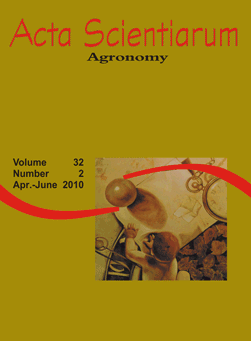<b>Morpho-anatomical characterization of embryogenic calluses from immature zygotic embryo of peach palm during somatic embryogenesis</b> - DOI: 10.4025/actasciagron.v32i2.3248
Keywords:
Bactris gasipaes, micropropagation, histology, morphology, callus anatomy, somatic embryos
Abstract
The objective of this study was to morpho-anatomically characterize nodular embryogenic calluses from zygotic embryos of peach palm during the induction of somatic embryogenesis. Immature zygotic embryos were pre-treated in MS medium added to Picloram and 2,4-D (25 µM) and BAP (0, 5, 10 µM). After three months, primary calluses were transferred to MS induction medium added to Picloram and 2,4-D (450 µM). After six months, the embryogenic calluses were then histologically analyzed and cultivated in the maturation medium. The competent tissues of the zygotic embryos differentiated embryogenic calluses under action of both Picloram and 2,4-D auxins (450 µM), where the presence of multi-granular structures were observed. Histological observations showed that in the nodular embryogenic calluses, the outlying parenchymal cells exhibit cellular characteristics of high mitotic activity. Differentiation of tracheal elements exists in embryogenic calluses connecting the callus to the explant. The evaluated cytokinin/auxin interaction influences the development of embryogenic calluses and globular structures.Downloads
Download data is not yet available.
Published
2010-04-27
How to Cite
Maciel, S. A., Fermino Junior, P. C. P., Silva, R. A., & Scherwinski-Pereira, J. E. (2010). <b>Morpho-anatomical characterization of embryogenic calluses from immature zygotic embryo of peach palm during somatic embryogenesis</b> - DOI: 10.4025/actasciagron.v32i2.3248. Acta Scientiarum. Agronomy, 32(2), 263-267. https://doi.org/10.4025/actasciagron.v32i2.3248
Issue
Section
Genetics and Plant Breeding
DECLARATION OF ORIGINALITY AND COPYRIGHTS
I Declare that current article is original and has not been submitted for publication, in part or in whole, to any other national or international journal.
The copyrights belong exclusively to the authors. Published content is licensed under Creative Commons Attribution 4.0 (CC BY 4.0) guidelines, which allows sharing (copy and distribution of the material in any medium or format) and adaptation (remix, transform, and build upon the material) for any purpose, even commercially, under the terms of attribution.
2.0
2019CiteScore
60th percentile
Powered by 

2.0
2019CiteScore
60th percentile
Powered by 



















































